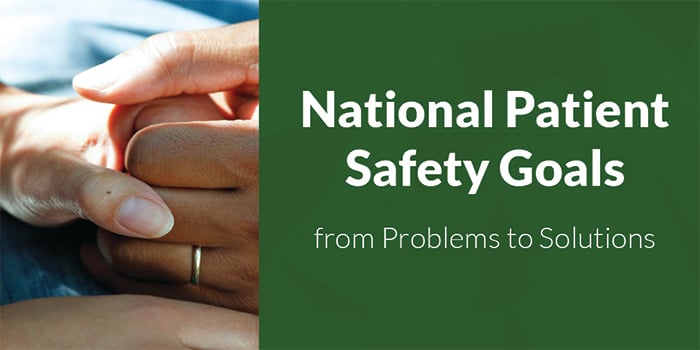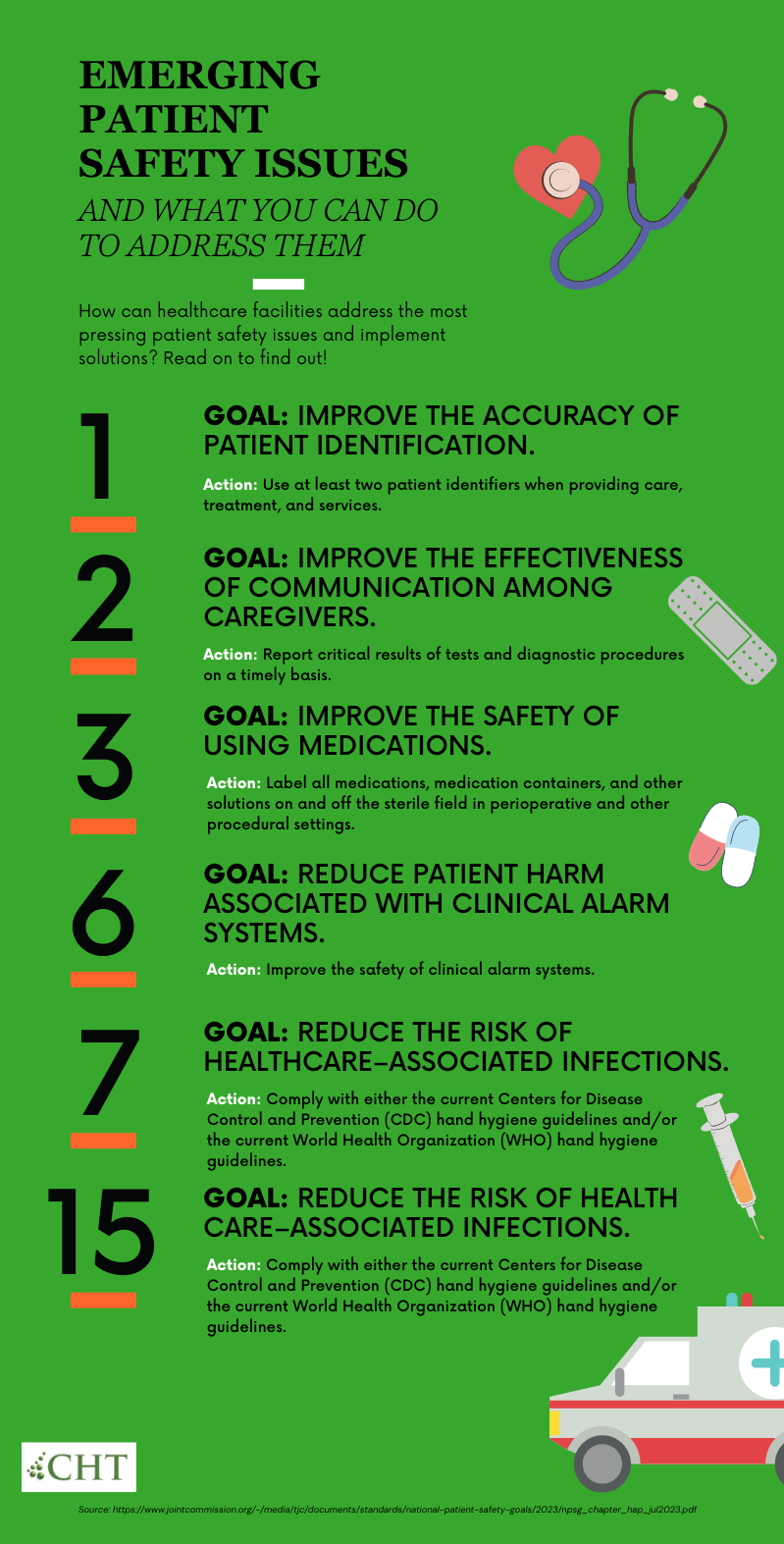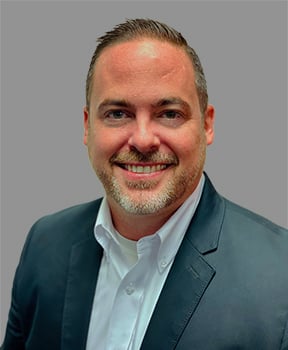
Patient safety is a critical element of an efficient and effective healthcare facility.
Every year, The Joint Commission's (TJC) safety goals are updated to provide the highest standard of care for patients. TJC approves changes to its National Patient Safety Goals (NPSGs) to address the best practices to achieve patient safety.
National Patient Safety Goals are designed specifically to assist hospitals and healthcare organizations in safeguarding their patients against errors, injuries, accidents, and infections.
At CHT, we understand you want your medical gas systems to be compliant, pass inspections, and be safe for your facility. We provide quick access to compliance documentation when you need it and identify maintenance issues before becoming patient issues.
This article discusses the emerging patient safety issues and what action you can take to address them.

Every day, patients experience adverse events and safety problems that are entirely preventable, and many pay the ultimate price. As many as 250,000 people die every year from preventable errors in hospitals; it is the third leading cause of death in hospitals, after heart disease and cancer.
How can healthcare facilities address patient safety issues and implement solutions?

National Patient Safety Goals
Goal #1 - Improve the accuracy of patient identification.
Identify patients correctly and describe the appropriate patient identifiers.
Use at least two ways to identify patients when providing care, treatment, and services. For example, use the patient's name and date of birth. This is done to make sure that each patient gets the correct medicine and treatment.
Effective July 2023, Element(s) of Performance for NPSG.01.01.01 cites to use at least two patient identifiers when providing laboratory services.
- Use at least two patient identifiers when administering medications, blood, or blood components; when collecting blood samples and other specimens for clinical testing; and when providing treatments or procedures. The patient's room number or physical location is not used as an identifier.
- Label containers used for blood and other specimens in the presence of the patient.
- Use distinct methods of identification for newborn patients.
Goal #2 - Improve the effectiveness of communication among caregivers.
Report critical results of tests and diagnostic procedures on a timely basis.
Communication errors play a significant role in contributing to safety problems at hospitals. Healthcare professionals need to improve staff communication and take measures to optimize this communication.
Getting actual test results to the right staff person on a timely basis so the patient can be promptly treated is a start.
Recently, based on the Element(s) of Performance for NPSG.02.03.01, healthcare professionals need to:
- Develop written procedures for managing the critical results of tests and diagnostic procedures that address the following:
- The definition of critical results of tests and diagnostic procedures.
- By whom and to whom critical results of tests and diagnostic procedures are reported.
- The acceptable length of time between the availability and reporting of critical results of tests and diagnostic procedures.
- Implement the procedures for managing the critical results of tests and diagnostic procedures.
- Evaluate the timeliness of reporting the critical results of tests and diagnostic procedures.
Goal #3 - Improve the safety of using medicines.
Conducted in February 2020 by Sage Growth Partners, a healthcare consulting group, surveyed executives, physicians, nurses, and more about their top patient safety challenges.
The survey consisted of where the most safety improvements are occurring, if technology-enhanced patient safety, and which patient-safety improvement approaches are most successful.
"Medication errors top hospitals' safety challenges, but 40% of respondents say error rates are decreasing."
Medication errors include patients getting the wrong drugs, the wrong dosage, or a combination of drugs that interact poorly.
Twenty-nine percent reported reducing medication errors as their organization's top safety improvement initiative for 2020. [source]
Mistakes with medicine...
More than 1 million times a year, patients in the US are given the wrong medication or the wrong dose of medication while in the hospital. Healthcare facilities need to prevent patient harm from incorrect labeling of medications.
Goal #6 - Reduce patient harm associated with clinical alarm systems.
Clinical alarm systems are intended to alert caregivers of potential patient problems, but they can compromise patient safety if they are not adequately managed.
Medical systems are monitored with alarms that activate when there is a pressure change or other type of issue that requires attention. The alarms warn of a lack of supply, overall system operation, and the condition of the medical gases being delivered. The master alarms are the most comprehensive of alarm panels and are often monitored by individuals not properly trained on the panel's functionality.
Learn more in CHT’s article: Master Alarm Panel for Medical Gas.
Goal #7 - Reduce the risk of healthcare-associated infections.
Every year, 1 in every 25 patients develops an infection while in the hospital. This is an infection that didn't have to happen.
Use the hand cleaning guidelines from the Centers for Disease Control and Prevention (CDC) and/or the current World Health Organization (WHO).
Hospitals and healthcare facilities need to follow the Elements of Performance for NPSG.07.01.01 by complying with the agencies and set goals for improving compliance with hand hygiene guidelines. And improve compliance with hand hygiene guidelines based on the established goals.
Effective teams can lower infection rates by implementing preventative measures and protocols to avoid errors and infections.
Goal #15 - Identify and address safety risks inherent in its patient population.
In general...
- The organization needs to conduct an environmental risk assessment that identifies features in the physical environment that could be used to attempt suicide.
- Screen all individuals served for suicidal ideation using a validated screening tool.
- Document individuals' overall level of risk for suicide and the plan to mitigate the risk for suicide.
- Follow written policies and procedures addressing the care of individuals served identified as at risk for suicide.
Introduction to the Universal Protocol for Preventing Wrong Site, Wrong Procedure, and Wrong Person Surgery™
Prevent mistakes in surgery:
Introduce the Universal Protocol for Preventing Wrong Site, Wrong Procedure, and Wrong Person Surgery™, and describe mandated pre-procedure processes and their prevention.
"A robust approach using multiple, complementary strategies is necessary to achieve the goal of always conducting the correct procedure on the correct person, at the correct site."
Elements of Performance:
UP.01.01.01
- Ensure that the correct surgery is done on the right patient and adequately placed on the patient’s body.
- Identify the items that must be available for the procedure and use a standardized list to verify their availability.
- Match the items that are to be available in the procedure area to the patient.
UP.01.02.01
- Mark the correct place on the patient’s body where the surgery is to be done.
- A written, alternative process is in place for patients who refuse site marking.
UP.01.03.01
- Pause before the surgery to make sure that a mistake is not being made.
Resource: National Patient Safety Goals Effective July 2023 for the Hospital Program
Patient safety is essential to delivering quality health services. These services must be timely, integrated, and efficient.
At CHT, we know you want to be confident that your medical gas management program is compliant. To do that, you need a successful survey outcome to increase your patients’ safety while reducing costs.
How to Begin the Process of Selecting a Medical Gas Compliance Partner
In Summary
Improving patient safety is among hospitals' top three priorities: delivering high-quality care, increasing efficiency, and reducing costs.
Each year, healthcare providers must meet The Joint Commission's National Patient Safety Goals requirements as part of their accreditation process.
Understanding the update of the National Patient Safety Goals ensures your organization complies with the requirements. Failing to meet a requirement will result in a condition for improvement.
In healthcare facilities, patient safety is a top priority but does come with its fair share of challenges. Healthcare professionals can join together to open the line of communication, develop a safety culture, be transparent, and strive to achieve excellence.
The solutions to current and future patient safety challenges include obtaining correct information and education and implementing the knowledge.




